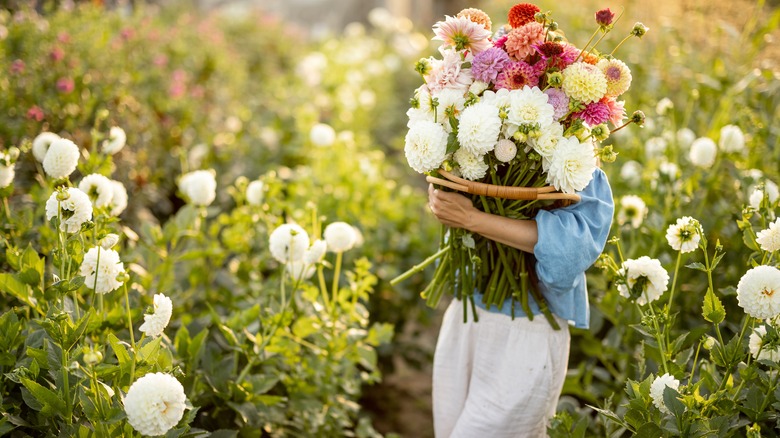The Best Place To Plant Dahlias For Stunning Blooms
When planning your dahlia garden, layout is crucial to its success. While that shady spot in your yard may seem ideal for flamboyant dahlia blooms, it may not be the wisest choice. Native to the high plains of Mexico, the plant was originally exposed to warmer climates. However, they grow well in cooler climates and have been grown successfully in Europe for over 200 years. Dahlia expert, Erin Benzakein, agreed that the plant is adaptable, revealing in an interview with Superbloom, "Dahlias are one of the most prolific and rewarding cut flowers you can possibly grow and bloom abundantly from late summer through autumn in most climates."
Interestingly, your location is also important. Depending on the USDA hardiness zone, dahlias can be classified as either perennials or annuals. Per the Old Farmer's Almanac, the Asteraceae family members are treated as annuals in zones 7 and below, while in zones 8 and above, they are considered perennials. While annuals have a longer flowering season and then die, perennials have a shorter season but often regrow from their tubers for a few years afterward. If you live in a warmer climate, carefully consider your dahlia placement as the perennials will bloom again the following spring. If you're in a cooler zone, you can have fun placing the flowers in various spots around your yard.
Dahlias love the sun
Dahlias grow best when they can bask in the sun. The plants thrive in a climate that boasts warm days and cool nights, much like its native Mexican climate. If you live in a region like this, feel free to plant your beds in direct sunlight to let them enjoy at least 6 to 8 hours of direct sun daily. However, if summer temperatures regularly breach 100 degrees Fahrenheit, often occurring in zones 7 to 10, dahlias may flourish in partially shaded areas instead. In fact, the award-winning dahlia growers at Bear Creek Farm, share that once the thermometers surpass the 90 degree Fahrenheit mark, the flowers won't bloom. However, they will again flower as soon as the temperature decreases.
Now, this isn't to say dahlias will only blossom in a sunny environment. While the flowers grow best with a lot of sun exposure, they can also grow in shady landscapes. The flowers will adapt to a shadier environment but these blooms will need some extra TLC, such as having to be staked more often. Dahlias that are grown in the shade also tend to be taller than their sun-soaked counterparts. Who wouldn't want a show of color in cool and shady spots of their garden?While these blooms have adapted to many weather conditions, be mindful that dahlias may need protection from cold winters. Knowing what to do is crucial to their survival.
Will dahlias grow in pots?
Whether you enjoy a balcony garden or simply prefer the flexibility of container plants, many gardeners like to have the option of potting their blooms. Dahlias do not like wet feet, preferring, well-drained and aerated soil, so these tubers can be grown in pots successfully. Garden center owner Steven Edney told The Middle-Sized Garden that dahlias can thrive in pots if they are large enough. "The important thing is to remember that the bigger the dahlia, the bigger the pot should be. Firstly that will help stop them drying out on hot days. Secondly, it will help prevent them blowing over in the wind," he stated. However, Edney also clarified that just because the plants can be grown in pots, they won't thrive indoors. He said, "Dahlias can't be grown as a house plant, no... The light levels are just too low. But if you have a conservatory, that might work."
Keep in mind that smaller dahlia varieties are more generally better suited as potted plants. Sun or shade, in a garden or pot, the floral extravaganza of dahlias is accessible to anyone willing to take the time to find the perfect spot for these blooms.


